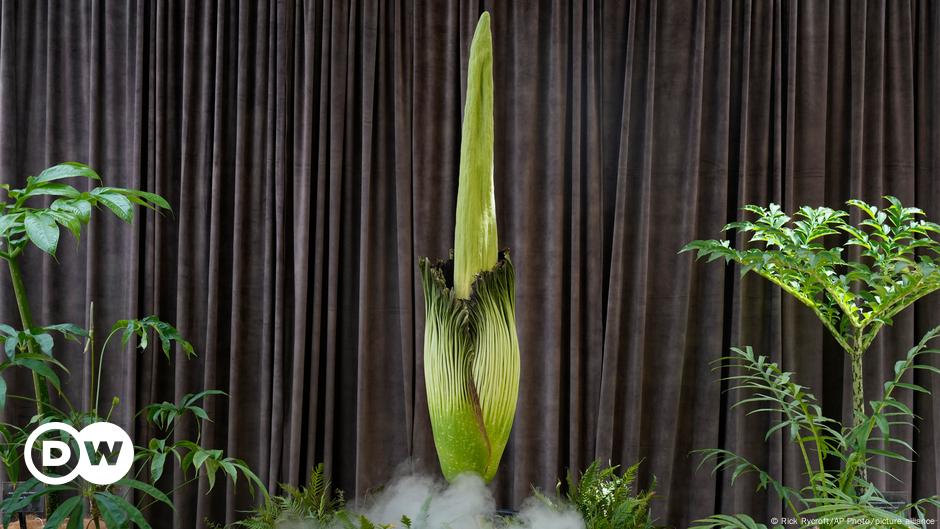Three-hour queues filled with people waiting to smell the smell of rotting meat seem an unusual tourist attraction, but the discovery is the lure of a rare flower blooming in an Australian greenhouse.
A “corpse flower” inside Sydney’s Royal Botanic Gardens has drawn more than 20,000 curious spectators for a special display ahead of its highly anticipated opening.
Thesis flowers are rare bloomers. In the case of this particular specimen, this is the first time it has been opened since 2010.
Why is it called ‘corpse flower’?
Corpse flower, native to the Indonesian island of Sumatra, gets its name from the literal translation of the Indonesian phrase bunga bangkai,
Name of its species, a kind ofMavehile, means “titanic misshapen penis” in ancient Greek.
These are accurate descriptions. Some corpse florets have been known to grow up to three meters tall before revealing a phallic spadix (or spike), while the odor released by the spadix to attract insects is often used to lyse decaying flesh. .
However, corpse flowers are many and varied, and the term is used loosely to describe flowers that emit the smell of death to attract carrion insects. These insects lay their eggs on the spadix.
The corpse flower kept in the Sydney Palm House has been Christianized as “Putricia” – a combination of the woman’s name Patricia, and the aptly descriptive word putrid.
How often do corpse flowers bloom?
While putaria bloomed for the first time in 15 years, corpus flower blooms are frequent. Many will bloom once a decade, although sometimes more frequently.
The lifecycle depends on the time it takes for the “corm” of the flower to gather energy to bloom. This heavy bulb-like structure usually cycles through “leaf” stylets, which send up a stem from the corm. This enables the plant to photosynthesize and build up the energy reserves of the corm before it dies.
When enough energy has been stored through the thesis leaf cycle, the flowering phase begins.
The bloom lasts for a day, with the spathe (the purple, petal-like structure surrounding the spadix) taking hours to completely unfurl.
The scent attracts insects which lay their eggs in decaying flesh, but the female flowers have the advantage of passing pollen between the reproductive cycles of the flower’s flowers.
Corpus flowers have a small chance of reproducing
In the wild, pollination requires careful timing.
Corpse flowers have both male and female flowers. Female flowers open first to prevent a plant from being pollinated. Nearby flowers need to bloom at the same time for cross pollination to be possible.
“The fact that they open so rarely … is clearly something that puts them at a bit of a disadvantage in the wild,” said Daniel at the Royal Botanic Gardens Sydney.
“When they open, they hope another flower is open nearby, because they can’t self-pollinate.” Daniel said.
Botatints want to try hand-pollinating Putrichia on the off chance that nothing happens.
What is the smell of a corpse flower?
A 2023 study conducted by researchers at Dartmouth College, US, determined the molecules found in the perfume emitted by the corpse flower. Among the chemicals emitted during female flowers:
- Dimethyl disulfide, which smells like garlic
- Dimethyl trisulfide, which can smell like a mixture of rotting meat and cabbage
- 3-Methylbutanol, which can smell like ripening soft cheese
- Dimethyl sulfide and methanethiol, which smell like boiled or rotting cabbage
- methyl thioacetate, which has a sulfur odor
- Isovaleric acid, similar to smelly feet
How many corpse flowers are left in the wild?
The number of corpse flowers has declined in the wild due to land clearing and poaching.
It is estimated that there are approximately 300 left in the wild and 1,000 in threatened settings.
Do you have a corpse flower?
You don’t need to travel to the mountainous landscape of Sumatra to see a corpse flower blooming.
Many botanical gardens around the world house them. Greenhouses are particularly good for tropical species to be discovered as thesis, due to their humid temperatures that replicate the conditions of their native habitat.
Botanical gardens in the US, Canada, Brazil, Europe, China, India and parts of Africa have promoted their own viewing glasses in recent years.
edited by: Zulfiqar Abney






Leave a Reply